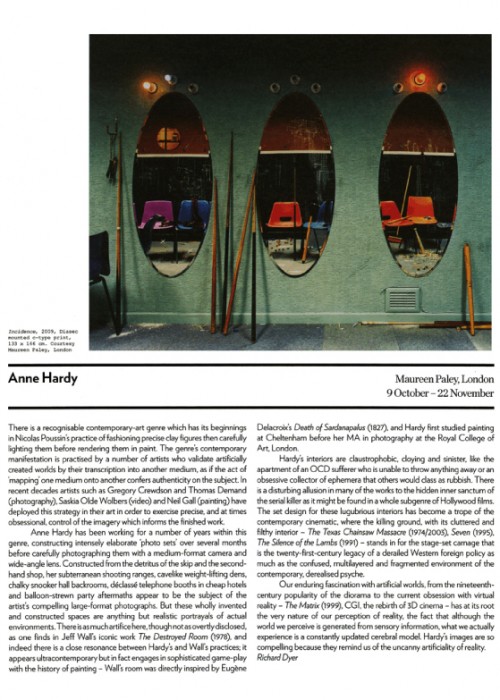| There is a recognisable contemporary-art genre which has its beginnings in Nicolas Poussin’s practice of fashioning precise clay figures then carefully lighting them before rendering them in paint. The genre’s contemporary manifestation is practised by a number of artists who validate artificially created worlds by their transcription into another medium, as if the act of ‘mapping’ one medium onto another confers authenticity on the subject. In recent decades artists such as Gregory Crewdson and Thomas Demand (photography), Saskia Olde Wolbers (video) and Neil Gall (painting) have deployed this strategy in their art in order to exercise precise, and at times obsessional, control of the imagery which informs the finished work. |
Anne hardy has been working for a number of years within this genre, constructing intensely elaborate ‘photo sets’ over several months before carefully photographing them with a medium-format camera and wide-angle lens. Constructed from the detritus of the skip and the second-hand shop, her subterranean shooting ranges, cavelike weight-lifting dens, chalky snooker hall back rooms, déclassé telephone booths in cheap hotels and balloon-strewn party aftermaths appear to be the subject of the artist’s compelling large-format photographs. But these wholly invented and constructed spaces are anything but realistic portrayals of actual environments. There is as much artifice here, though not as overly disclosed, as one finds in Jeff Wall’s iconic work The Destroyed Room (1978), and indeed there is a close resonance between Hardy’s and Wall’s practices; it appears ultra contemporary but in fact engages in sophisticated game-play with the history of painting – Wall’s room was directly inspired by Eugène Delacroix’s Death of Sardanapalus (1827), and Hardy first studied painting at Cheltenham before her MA in photography at the Royal College of Art, London. |
Hardy’s interiors are claustrophobic, cloying and sinister, like the apartment of an OCD sufferer who is unable to throw anything away or an obsessive collector of ephemera that others would class as rubbish. There is a disturbing allusion in many of the works to the hidden inner sanctum of the serial killer as it might be found in a whole sub genre of Hollywood films. The set design for these lugubrious interiors has become a trope of the contemporary cinematic, where the killing ground, with its cluttered and filthy interior ― The Texas Chainsaw Massacre (1974/2003), Seven (1995), The Silence of the Lambs (1991) ― stands in for the stage-set carnage that is the twenty-first century legacy of a derailed Western foreign policy as much as the confused, multilayered and fragmented environment of the contemporary, derealised psyche.
Our enduring fascination with artificial worlds, from the nineteenth-century popularity of the diorama to the current obsession with virtual reality ― The Matrix (1999), CGI, the rebirth of 3D cinema ― has its root the very nature of our perception of reality, the fact that although the world we perceive is generated from sensory information, what we actually experience is a constantly updated cerebral model. Hardy’s images are so compelling because they remind us of the uncanny artificiality of reality. |
Richard Dyer, Art Review, 2010.  |
